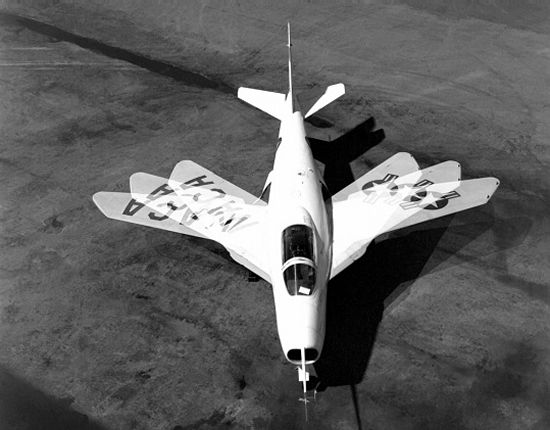|
||||||||||
|
|
||||||||||
|
||||||||||
|
|
||||||||||
 - -
|
|

|
Bell X-5 Variable Sweep Research Aircraft |
|
DESCRIPTION:
In the closing days of World War II, US forces captured a German facility were Messerschmitt had nearly completed construction of its P.1101 prototype. This a research aircraft had been built to study the effects of different angles of wing sweep during flight. After being shipped to the US for analysis at Wright Field in Ohio, Bell took possession of the aircraft as a test vehicle for a variable wing-sweep mechanism. The P.1101 had been damaged and was not airworthy, but analysis of the design convinced Bell and the US Air Force to construct two similar aircraft, known as the X-5, for flight tests. The final design, bearing a clear resemblance to the original Messerschmitt craft, featured a mechanism allowing the wings to move fore and aft as they were swept between angles of 20, 45, and 60 degrees in flight. Although the wing-sweep mechanism was found to be impractical for use on future aircraft, the X-5 validated wind-tunnel tests indicating that increasing wing-sweep when approaching Mach 1 would significantly reduce drag and improve aerodynamic performance. This data proved useful in designing the Air Force's F-111 bomber and the Navy's F-14 fighter. However, the X-5 itself was found to exhibit a severe stall-spin instability that resulted in the fatal crash of the second example. The first X-5, after completing 133 test flights, was used as a chase plane for other research aircraft since its ability to change wing geometry made it well-suited to matching the flight characteristics of other aircraft. Upon its retirement, the #1 ship went on display at the US Air Force Museum in Ohio.
Last modified 26 September 2009
|
|
| HISTORY: | |
| First Flight |
20 June 1951
|
| CREW: |
one: pilot
|
|
ESTIMATED COST:
|
unknown
|
| AIRFOIL SECTIONS: | |
| Wing Root | NACA 64A011 |
|
Wing Tip
|
NACA 64A08.28
|
| DIMENSIONS: | |
| Length | 33.33 ft (10.16 m) |
| Wingspan |
30.81 ft (9.39 m) at minimum sweep 18.58 ft (5.66 m) at maximum sweep |
| Height | 12.00 ft (3.66 m) |
| Wing Area | unknown |
|
Canard Area
|
not applicable
|
| WEIGHTS: | |
| Empty | unknown |
| Normal Takeoff | unknown |
| Max Takeoff | 10,000 lb (4,535 kg) |
| Fuel Capacity |
internal: unknown external: unknown |
|
Max Payload
|
unknown
|
| PROPULSION: | |
| Powerplant | one Allison J35-17A turbojet |
| Thrust |
4,900 lb (21.80 kN)
|
| PERFORMANCE: | |
| Max Level Speed |
at altitude: unknown at sea level: 650 mph (1,045 km/h) |
| Initial Climb Rate | unknown |
| Service Ceiling | unknown |
| Range | unknown |
| g-Limits |
unknown
|
| KNOWN VARIANTS: | |
| X-5 #1 | First example built, used as a NACA test aircraft from 1951 until 1955 and completed 133 flights, later used as a chase plane and now on display at the US Air Force Museum |
| X-5 #2 |
Second example operated by Bell and the US Air Force, destroyed in a fatal crash resulting from an
uncontrolled spin on 13 October 1953
|
|
KNOWN OPERATORS:
|
United States (US Air Force) United States (NASA) |
|
3-VIEW SCHEMATIC:

|
|
SOURCES:
|
|


|
Aircraft | Design | Ask Us | Shop | Search |

|
|
| About Us | Contact Us | Copyright © 1997- | |||
|
|
|||